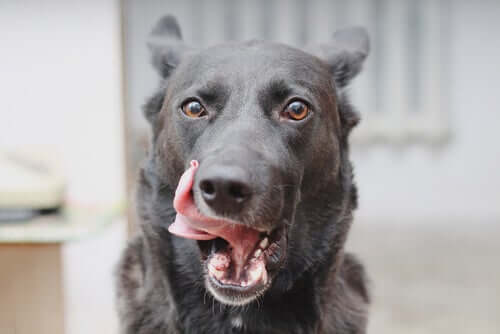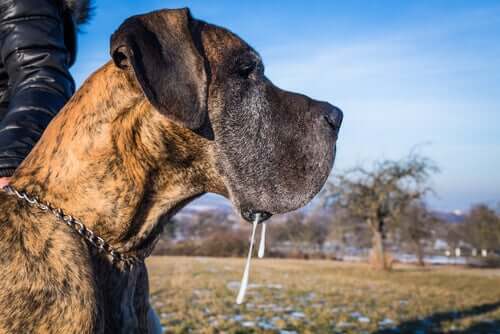Why Do Dogs Lick Their Lips?

Have you ever wondered if when dogs lick their lips, they’re actually trying to tell you something? If you see a dog doing this, you can assume it’s just eating or salivating over something. But what if there’s no food involved? Why do dogs lick their lips when that’s the case?
Why do dogs lick their lips?
Anticipating food
The most obvious reason for a dog to be licking its lips is in anticipation of food. That anticipation is also a frequent cause for the build-up of saliva in their mouths.

In fact, this is even common in humans when we’re hoping for, or getting ready to eat, something tasty.
It’s sending a signal of calmness
According to professional trainers, when a dog quickly licks its lips then pulls its tongue back in, it’s generally a sign of calmness. Dog trainers call this, and other similar behavior, “calming signals.”
It all comes down to the fact that dogs will often lick their lips when they feel stressed or uncomfortable about something going on around them. If they feel like they’re in a threatening situation, they may use a calming signal to avoid any conflict.
You can see a clear example of this in dogs that get punished for anything they do wrong. In this case, the dog sees their owner as the threat. So what the dog does is offer a calming signal by licking its lips and avoiding eye contact. This is a way for the dog to communicate that it’s not a threat to the person or animal that’s behaving aggressively.
Dogs may lick their lips out of fear
A dog that’s scared may also lick its lips. Dogs sometimes do things like lick their lips and yawn when they’re frustrated or confused. Many owners notice things like this when they’re training their dogs, if the dog is having problems understanding a particular lesson.
Nausea, pain, or dental issues
Another potential reason a dog may lick its lips has to do with its health. Things like nausea, dental issues, or pain in the mouth may lead it to do this. So, if your dog is licking its lips or drooling more than it normally does, take it to the vet. You’ll want to rule out the possibility of any serious illnesses causing the excess licking.

If this is happening, look out for other signs of illness, and keep a close eye on your dog. It could also be experiencing more serious physical issues, or a digestive problem.
It may be from anxiety
There was some research into how dogs behave when their owners have been gone for thirty minutes, two hours, and four hours. The researchers found that, the longer the separation, the more dogs would lick their lips and shake their bodies when their owners came back.
If your dog licks its lips a lot when it’s at the vet with you, or gets nervous in any other place, try to redirect its attention in a positive way. For example, you could ask it to do a trick and then give it a treat once it does the trick right. Try not to simply console your dog when it’s feeling uncomfortable. That sounds mean, but consolation will only reinforce its fear and anxiety.
Lastly, when a dog licks its lips, it’s also communicating in a silent language that has roots in the days when dogs lived in packs.
Calming signals
Dogs develop calming signals as a way to communicate and avoid conflicts among themselves. We don’t know exactly how many they have, but some people estimate that dogs have about 30 different calming signals. They use them in their interactions with both humans and other dogs.
It’s important to pay attention to how and when your dog licks its lips. Doing that could give you a hint about whether it’s feeling anxious or stressed. In the end, every dog is different, and you just need to spend a while observing it. After that, you’ll learn to be able to “read” its messages with perfect clarity.
All cited sources were thoroughly reviewed by our team to ensure their quality, reliability, currency, and validity. The bibliography of this article was considered reliable and of academic or scientific accuracy.
- Firnkes, A., Bartels, A., Bidoli, E., & Erhard, M. (2017). Appeasement signals used by dogs during dog–human communication. Journal of Veterinary Behavior, 19, 35-44.
- Siniscalchi, M., d’Ingeo, S., Minunno, M., & Quaranta, A. (2018). Communication in dogs. Animals, 8(8), 131.
- Bueno, R. Á. (2018). Etología canina: Guía básica sobre el comportamiento del perro. Veterinaria.
- Ruíz Ferro, C., & Cantor Muñoz, P. (2019). ¿Cómo hablar perro?: perro negro, diseño animal. Repositorio de tesis de la Universidad de Bogotá Jorge Tadeo Lozano
